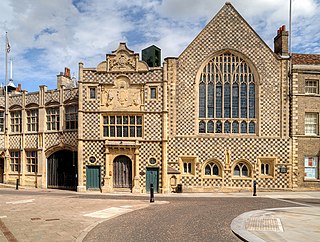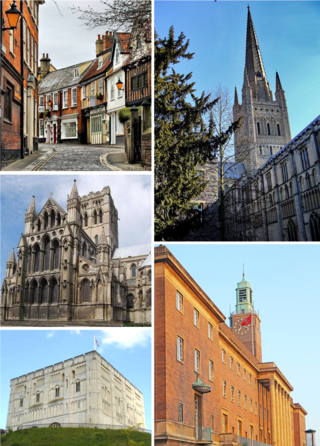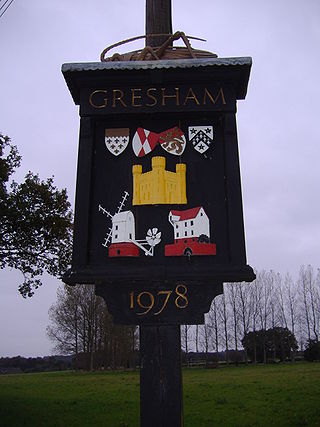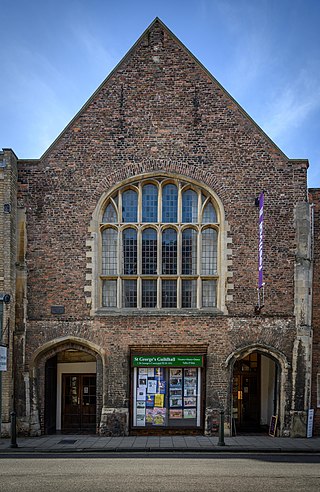
Norfolk is a ceremonial county in the East of England and East Anglia. It borders Lincolnshire and The Wash to the north-west, the North Sea to the north and east, Cambridgeshire to the west, and Suffolk to the south. The largest settlement is the city of Norwich.

Blakeney is a coastal village and civil parish in the English county of Norfolk. Blakeney lies within the Norfolk Coast AONB and the North Norfolk Heritage Coast. The North Norfolk Coastal Path travels along its quayside. The village is 21.1 mi (34 km) north west of Norwich, 4.6 mi (7.4 km) NNW of the larger settlement of Holt, 11.5 mi (18.5 km) west of Cromer and 112 mi (180 km) NNE of London.

Wymondham is a market town and civil parish in the South Norfolk district of Norfolk, England, 12 miles (19 km) south-west of Norwich off the A11 road to London. The River Tiffey runs through. The parish, one of Norfolk's largest, includes rural areas to the north and south, with hamlets of Suton, Silfield, Spooner Row and Wattlefield. It had a population of 14,405 in 2011, of whom 13,587 lived in the town itself.

Norwich is a cathedral city and district of the county of Norfolk, England of which it is the county town. Norwich is by the River Wensum, about 100 mi (160 km) north-east of London, 40 mi (64 km) north of Ipswich and 65 mi (105 km) east of Peterborough. As the seat of the See of Norwich, with one of the country's largest medieval cathedrals, it is the largest settlement and has the largest urban area in East Anglia. The population of the Norwich City Council local authority area was estimated to be 144,000 in 2021, which was an increase from 143,135 in 2019. The wider built-up area had a population of 213,166 in 2019.

Aylsham is a historic market town and civil parish on the River Bure in north Norfolk, England, nearly 9 mi (14 km) north of Norwich. The river rises near Melton Constable, 11 miles (18 km) upstream from Aylsham and continues to Great Yarmouth and the North Sea, although it was only made navigable after 1779, allowing grain, coal and timber to be brought up river.
The Paston Letters is a collection of correspondence between members of the Paston family of Norfolk gentry and others connected with them in England between the years 1422 and 1509. The collection also includes state papers and other important documents.

Norwich Castle is a medieval royal fortification in the city of Norwich, in the English county of Norfolk. William the Conqueror (1066–1087) ordered its construction in the aftermath of the Norman Conquest of England. The castle was used as a gaol from 1220 to 1887. In 1894 the Norwich Museum moved to Norwich Castle. The museum and art gallery holds significant objects from the region, especially works of art, archaeological finds and natural history specimens.

Weeting Castle is a ruined, medieval manor house near the village of Weeting in Norfolk, England. It was built around 1180 by Hugh de Plais, and comprised a three-storey tower, a substantial hall, and a service block, with a separate kitchen positioned near the house. A moat was later dug around the site in the 13th century. The house was not fortified, although it drew on architectural features typically found in castles of the period, and instead formed a very large, high-status domestic dwelling. It was probably intended to resemble the hall at Castle Acre Castle, owned by Hugh's feudal lord, Hamelin de Warenne.

Paston Great Barn is a medieval barn near Paston Hall on the southeast edge of the village of Paston in northeast Norfolk, owned by the North Norfolk Historic Buildings Trust. Dating from 1581, the building has a long association with the Paston family. A scheduled monument and a grade II* listed building, the barn is the centre of a 0.95 hectares biological Site of Special Scientific Interest, a National Nature Reserve and a Special Area of Conservation. It is in the Norfolk Coast Area of Outstanding Natural Beauty.

Gresham is a village and civil parish in North Norfolk, England, five miles (8 km) south-west of Cromer.

Hellesdon is a village in the District of Broadland in Norfolk, England. It lies approximately four miles (6 km) north-west of Norwich city centre and has a population of 11,132, according to the 2011 Census. Norwich International Airport immediately adjoins the parish.

The Forum is a public building in Norwich, United Kingdom. The building opened in 2001 and was designed by the British architectural firm Sir Michael Hopkins and Partners. It was built to serve as a replacement to the Norwich Central Library, which burnt down on the site in 1994. After a proposal for a site named Technopolis was rejected, a second version, which was named New Technopolis before changing to the Forum, was constructed. The Norfolk and Norwich Millennium Library sits to the west end of the building, with office and commercial spaces and studios for the BBC around a main atrium. The building is fronted by a glass façade with a surrounding brick wall and inner steel frame supporting a glass and zinc panel roof. The project cost £66 million, of which £31 million was from the Millennium Commission. The library has been named one of the most popular in the country, while The Forum is a venue for public events and festivals and the outside plain hosts live performances. Despite winning several awards, the building has been criticised for its use of materials and has been likened to a shopping mall and airport terminal.

Cinema City is a Grade I listed cultural cinema in the city of Norwich in Norfolk, England. The building is owned by Norwich City Council and the site is managed by the charity Cinema City Ltd, charity number 288309. Commercial activities - film screenings, bar and restaurant - are carried out by Picturehouse Cinemas Limited which operates a national chain of 'art house' cinemas, called Picturehouse. Picturehouse is part of the Cineworld chain. Cinema City Ltd undertakes education activities on site and throughout Norfolk through its education arm Cinema Plus.

Paston is a village and civil parish in the English county of Norfolk. The village is 4 miles (6.4 km) north-east of North Walsham and 9.1 miles (14.6 km) south-east of Cromer. It is 19.2 miles (30.9 km) north-east of the city of Norwich. The village sits astride the coast road between Mundesley and Bacton. The nearest railway station is at North Walsham for the Bittern Line which runs between Sheringham, Cromer and Norwich. The nearest airport is Norwich International.

Chester Rows are a set of structures in each of the four main streets of Chester, in the United Kingdom, consisting of a series of covered walkways on the first floor behind which are entrances to shops and other premises. At street level is another set of shops and other premises, many of which are entered by going down a few steps.

Norwich Guildhall is a municipal building on Gaol Hill in the city of Norwich, United Kingdom. It is a Grade I listed building.

Norwich 12 was an initiative by the Norwich Heritage Economic and Regeneration Trust (HERT) to develop 12 of Norwich's most iconic buildings into an integrated family of heritage attractions to act as an international showcase of English urban and cultural development over the last 1,000 years.

Strangers' Hall is a Grade I listed building and museum of domestic history located in Norwich, UK. Throughout its 700-year history, Strangers' Hall has been the home to numerous Mayors of Norwich and has served both domestic and commercial functions. A courtyard house, the oldest part of the building is the 14th-century undercroft while further additions were made through to the 17th century by various merchants and mayors, most notably the Sotherton family, Francis Cock and Joseph Paine. The house ended up in the hands of the Roman Catholic church before being bought by Leonard Bolingbroke, who converted it into a folk museum at the start of the 20th century. He then gave the house to the city of Norwich, which has since run it as a museum of domestic history. Although other theories have been proposed regarding the origins of the name of the house, it is named after the Strangers, a group of Protestant refugees seeking political asylum from the Catholic Low Countries from 1565, some of whom lived in the hall.
Sir Henry Heydon was the son of John Heydon of Baconsthorpe, Norfolk, 'the well-known opponent of the Paston family'. He married Anne Boleyn, the daughter of Sir Geoffrey Boleyn, great-grandfather of Henry VIII's queen Anne Boleyn.

The Guildhall of St George is a Grade I listed building in King’s Lynn, Norfolk, England. The Guild of St George was founded in 1376 and constructed the Guildhall between 1410 and 1420. It is the largest extant guildhall in England. It has been in use as a theatre since 1445, making it the oldest theatre still operating in the United Kingdom, and the only one still in existence in which William Shakespeare is believed to have performed. The building is in the ownership of the National Trust, which has leased it to King's Lynn and West Norfolk borough council for hire as a music, performances, lectures and entertainment venue.




















